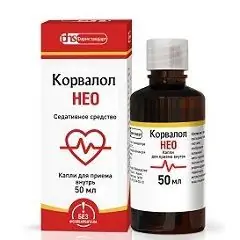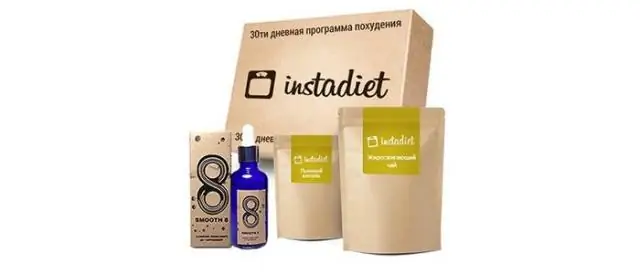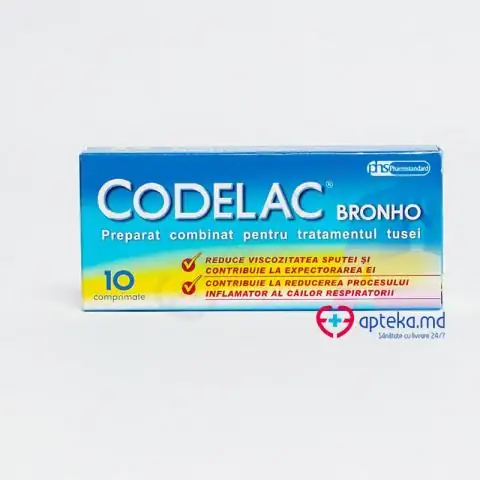- Author Rachel Wainwright [email protected].
- Public 2023-12-15 07:39.
- Last modified 2025-11-02 20:14.
Corvalol Neo
Corvalol Neo: instructions for use and reviews
- 1. Release form and composition
- 2. Pharmacological properties
- 3. Indications for use
- 4. Contraindications
- 5. Method of application and dosage
- 6. Side effects
- 7. Overdose
- 8. Special instructions
- 9. Application during pregnancy and lactation
- 10. Use in childhood
- 11. In case of impaired renal function
- 12. For violations of liver function
- 13. Use in the elderly
- 14. Drug interactions
- 15. Analogs
- 16. Terms and conditions of storage
- 17. Terms of dispensing from pharmacies
- 18. Reviews
- 19. Price in pharmacies
Latin name: Corvalol Neo
ATX code: N05CM
Active ingredient: diphenhydramine (Diphenhydramine) + peppermint leaves oil (Menthae piperitae foliorum oleum) + motherwort herb tincture (Motherwort herb tincture) + ethylbromisovalerianate (Ethylbromisovalerinate)
Producer: JSC "Pharmstandard-Leksredstva" (Russia)
Description and photo update: 2019-12-07
Prices in pharmacies: from 50 rubles.
Buy

Corvalol Neo is a sedative.
Release form and composition
The drug is produced in the form of drops for oral administration: a transparent greenish-brown liquid with a characteristic odor; during storage, turbidity and the formation of a precipitate in the form of flakes and / or particles, forming a suspension of small particles upon shaking (25 or 50 ml each in glass vials / dropper vials, sealed with dropper stoppers with screw caps; in a cardboard box 1 vial / vial -dropper and instructions for use of Corvalol Neo).
1 ml of oral drops contains:
- active ingredients: diphenhydramine hydrochloride - 1 mg, ethyl bromisovalerianate (ethyl ester of alpha-bromisovaleric acid) - 20 mg, motherwort herb tincture (motherwort tincture *) - 720 mg, peppermint leaf oil (peppermint oil) - 1.42 mg;
- additional component: purified water.
* To obtain 1000 ml of motherwort tincture, 200 g of motherwort herb and a sufficient volume of ethyl alcohol 70% are used.
Pharmacological properties
Pharmacodynamics
Corvalol Neo is a combined drug with an antispasmodic, sedative and moderate cardiotonic effect (increases the strength of heart contractions and slows down their rhythm), and also demonstrates a moderate hypotensive effect.
The effect of the drug is due to the properties of the Neo-active substances included in Corvalol:
- diphenhydramine (I generation H 1 histamine receptor blocker): weakens or prevents histamine-related smooth muscle spasms, prevents increased capillary permeability, tissue edema, hyperemia and itching, has a hypnotic effect, provides antiemetic and sedative effects; the effect of the substance on the central nervous system (CNS) is caused by the blockade of H 2 -histamine receptors of m-cholinergic receptors of the cerebral cortex; antagonism with histamine is more pronounced in relation to local vascular reactions than to systemic ones, that is, to a decrease in blood pressure (BP);
- peppermint oil: has a reflex vasodilating, antispasmodic, antiseptic and mild choleretic effect; the mechanism of action is due to the ability of the active substance to irritate the cold receptors of the oral mucosa and reflexively expand mainly the vessels of the brain and heart; helps to eliminate the phenomena of flatulence as a result of irritation of the receptors of the mucous membrane of the gastrointestinal tract (GIT) and increased intestinal peristalsis;
- ethyl bromisovalerianate: exhibits a sedative and antispasmodic effect due to irritation mainly of receptors of the oral cavity and nasopharynx, weakening of reflex excitability in the central parts of the nervous system and an increase in inhibition in neurons of the cerebral cortex and subcortical structures, as well as ensuring a decrease in the activity of central vasomotor centers and direct local spasmolytic rendered on smooth muscle fibers; the nature of the action of the substance is similar to that of valerian preparations;
- motherwort herb: demonstrates a pronounced sedative effect, and also moderately slows down the heart rate and increases their intensity, has moderate hypotensive properties.
Pharmacokinetics
Data on the pharmacokinetics of motherwort herb, ethyl bromisovalerianate and peppermint oil are not available.
Diphenhydramine after oral administration of Corvalol Neo is rapidly absorbed in the gastrointestinal tract, bioavailability is 50%. This active substance binds to plasma proteins by 98-99%. The period for reaching the maximum concentration level (T Cmax) is 1.89 hours. The highest content of the substance is found in the spleen, liver, kidneys, lungs, muscles and brain. The maximum concentration of diphenhydramine (C max) is 2.32 ng / ml. The area under the pharmacokinetic curve AUC 0- ∞ is 11.75 ng⋅h / ml, the apparent volume of distribution (Vd) is 179 liters. Passes through the blood-brain barrier.
Diphenhydramine is metabolized mainly in the liver and to a lesser extent in the kidneys and lungs. Elimination rate constant (kel) is equal to 0.411 h -1. Within 24 hours, the substance is completely excreted by the kidneys in the form of metabolites conjugated with glucuronic acid. The half-life (T ½) is 1.9 hours.
Diphenhydramine metabolites are excreted in significant quantities in breast milk and can cause sedation in infants - a paradoxical reaction, manifested by excessive excitability, can be noted.
Indications for use
- sleep disturbance, the cause of which is not associated with organic disorders of the central nervous system (as a sedative);
- increased nervous irritability;
- neurasthenia.
Contraindications
Absolute:
- severe impairment of the kidneys and / or liver;
- epilepsy;
- stenosis of the bladder neck;
- hyperplasia of the prostate;
- erosive and ulcerative lesions of the gastrointestinal tract (during an exacerbation);
- pyloroduodenal stenosis;
- stenosing gastric ulcer and 12 duodenal ulcer;
- porphyria;
- bronchial asthma;
- angle-closure glaucoma;
- age up to 18 years;
- pregnancy and the period of breastfeeding;
- hypersensitivity to any component in Corvalol Neo.
Relative (it is recommended to use the drug under medical supervision):
- functional disorders of the kidneys;
- liver disease;
- chronic obstructive pulmonary disease (COPD);
- bronchitis;
- retention of urine;
- glaucoma;
- alcoholism;
- traumatic brain injury;
- diseases of the brain.
In addition, with caution, it is required to take Corvalol-Neo drops during therapy with MAO inhibitors or two weeks after their cancellation, as well as in elderly patients due to the more frequent development of side effects. Elderly patients with confusion are not recommended to take the drug.
Corvalol Neo, instructions for use: method and dosage
Corvalol Neo drops should be taken orally before meals, 3 times a day, 30 drops. A single dose must first be diluted in 30-40 ml of water, the course of therapy is 10-15 days. After consulting a specialist, a second course of treatment is possible, but not earlier than 1 month after the completion of the previous one.
Before use, the drops contained in the bottle should be shaken.
Side effects
- cardiovascular system: lowering blood pressure, slowing heart rate, extrasystole, tachycardia;
- immune system: allergic reactions such as rash, hives, shortness of breath, Quincke's edema;
- blood and lymphatic system: thrombocytopenia, hemolytic anemia, agranulocytosis;
- respiratory system, organs of the chest and mediastinum: dryness of the mucous membrane of the nasal cavity, bronchi (thickening of the structure of bronchial secretions);
- digestive system: nausea, dry mouth, dyspepsia, vomiting, anorexia, epigastric discomfort;
- nervous system: weakness, drowsiness, headache, fatigue, dizziness, deterioration in the ability to concentrate, decrease in the speed of psychomotor reactions, instability, impaired coordination and speed of reaction, dyskinesia, paresthesia, convulsions; in some cases - tremor, insomnia;
- mental disorders: paradoxical agitation (mostly in elderly patients), confusion; in some cases - euphoria, irritability;
- muscle, skeletal and connective tissue: muscle twitching;
- skin and subcutaneous tissue: photosensitivity;
- organ of vision: blurred vision;
- hearing organ and labyrinthine disorders: ringing in the ears;
- kidneys and urinary tract: difficulty urinating, urinary retention.
The above effects disappear when the dose is reduced or the drug is stopped. In the case of prolonged use of large doses of the drug, drug dependence may appear, as well as accumulation of bromine in the body and the development of bromism, manifested by such symptoms as conjunctivitis, rhinitis, apathy, depressed mood, impaired coordination of movements, hemorrhagic diathesis. Due to the risk of the toxic effect of the drug, it is not recommended to carry out long courses and use its high doses.
If any of the listed adverse reactions are aggravated, or any other adverse events occur, you should consult your doctor.
Overdose
An overdose of Corvalol Neo can occur with frequent and prolonged use of a sedative. Against the background of exceeding the recommended doses, the severity of dose-dependent undesirable effects may be aggravated. Overdose symptoms may include the following phenomena: dilated pupils, agitation / depression, hot flashes, fever, dry mouth, paresis of the gastrointestinal tract, tremors, dystonic reactions, depression of the central nervous system, hallucinations, changes in the electrocardiogram (ECG).
With significant intoxication, convulsions, rhabdomyolysis, toxic psychosis, delirium, arrhythmias, cardiovascular failure, coma may occur.
When these disorders appear, gastric lavage is prescribed, if necessary, symptomatic treatment is carried out - drugs that increase blood pressure, oxygen are administered, plasma-replacing fluids are injected intravenously. Analeptics and epinephrine cannot be used. There is no specific antidote.
If an overdose is suspected, it is necessary to discontinue therapy with Corvalol Neo and urgently consult a doctor.
special instructions
During the treatment period, it is required to avoid exposure to ultraviolet radiation (UV radiation), including exposure to the skin of direct sunlight.
With a prolonged course of therapy, resistance may arise, and prolonged use of drops in high doses can lead to the development of an overdose.
Diphenhydramine may increase existing tinnitus.
The attending physician should be informed about taking Corvalol Neo, since the antiemetic effect exerted by the sedative can make it difficult to diagnose appendicitis and establish signs of a possible overdose with other drugs.
Corvalol Neo contains 47.5% ethyl alcohol, from which it follows that when taken orally, the content of absolute ethyl alcohol in the maximum single dose is 0.308 g, in the maximum daily dose - 0.923 g.
Influence on the ability to drive vehicles and complex mechanisms
During therapy with Corvalol Neo, one should refrain from driving vehicles and controlling other complex and potentially dangerous mechanisms due to the possible appearance of blurred vision, decreased concentration, dizziness, coordination disorders and other undesirable phenomena caused by taking drops.
Application during pregnancy and lactation
It has been established that diphenhydramine can pass through the placenta, cases of the development of extrapyramidal disorders and jaundice in children whose mothers took this drug during pregnancy have been recorded. The use of diphenhydramine in the third trimester can cause adverse reactions in the newborn or lead to premature birth. During pregnancy, treatment with Corvalol Neo is contraindicated, since there are no data confirming the safety of using the drug in pregnant women.
Taking diphenhydramine while breastfeeding can provoke increased agitation and irritability in the baby. If it is necessary to treat Corvalol Neo during lactation, it is necessary to resolve the issue of transferring the child to artificial feeding.
Pediatric use
In patients under 18 years of age, the safety and efficacy of using Corvalol Neo have not been established, and therefore, sedative treatment for children and adolescents is not prescribed.
With impaired renal function
In severe renal impairment, Corvalol Neo is contraindicated.
Patients with moderate disorders should be treated with caution.
For violations of liver function
In the presence of severe liver dysfunction, drug therapy is contraindicated.
Patients with moderate liver disease take Corvalol Neo with caution.
Use in the elderly
During treatment, the development of adverse reactions of Corvalol Neo is most often recorded in elderly patients. It is recommended to avoid taking the drug in elderly patients with confusion.
Drug interactions
- analgesic, antispasmodic drugs: their effect is enhanced;
- apomorphine: its effectiveness as an emetic decreases in the treatment of poisoning;
- drugs, the primary metabolism of which is produced by CYP2D6: interactions with these drugs can potentially be observed, since diphenhydramine is an inhibitor of the CYP2D6 isoenzyme of cytochrome P 450;
- tricyclic antidepressants, atropine: the anticholinergic effects of these drugs may be enhanced;
- monoamine oxidase (MAO) inhibitors: the severity and duration of anticholinergic effects manifested by diphenhydramine increases (Corvalol Neo should be taken with extreme caution during therapy with MAO inhibitors or two weeks after their cancellation);
- ethanol and drugs that inhibit the activity of the central nervous system (hypnotics and sedatives, tricyclic antidepressants, tranquilizers, antipsychotics): mutual enhancement of effects can be recorded; in addition, ethanol increases the toxicity of Corvalol Neo (during the period of therapy, the intake of ethanol-containing drinks should be excluded);
- psychostimulants: there is an antagonistic interaction.
It is also necessary to avoid the use of Corvalol Neo in combination with other drugs that have antihistamines, including topical drugs, cough and cold medicines.
Analogs
The analogues of Corvalol Neo are: Bromenval, Valemidin, Valeodikramen, Valoserdin, Doppelgerts Melissa, Corvaldin, Corvalol Fito, Peony evading tincture, Motherwort tincture, Fito Novo-Sed, etc.
Terms and conditions of storage
Keep out of the reach of children at a temperature not exceeding 25 ° C.
Shelf life is 2 years.
Terms of dispensing from pharmacies
Available without a prescription.
Reviews of Corvalol Neo
Currently, there are not enough reviews on Corvalol Neo left by patients on medical sites, on the basis of which it would be possible to realistically assess the therapeutic effect and disadvantages of the drug.
Price for Corvalol Neo in pharmacies
The price of Corvalol Neo, drops for oral administration, can be 95-130 rubles. for a bottle of 50 ml.
Corvalol Neo: prices in online pharmacies
|
Drug name Price Pharmacy |
|
Corvalol NEO oral drops 50 ml 1 pc. RUB 50 Buy |
|
Corvalol NEO oral drops 25 ml 1 pc. 73 rbl. Buy |
|
Corvalol neo drops for oral administration in fl.-cap. 25ml No. 1 RUB 85 Buy |

Maria Kulkes Medical journalist About the author
Education: First Moscow State Medical University named after I. M. Sechenov, specialty "General Medicine".
Information about the drug is generalized, provided for informational purposes only and does not replace the official instructions. Self-medication is hazardous to health!






